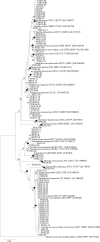Identification of polybacterial communities in patients with postoperative, posttraumatic, and endogenous endophthalmitis through 16S rRNA gene libraries
- PMID: 24574297
- PMCID: PMC3993652
- DOI: 10.1128/JCM.02093-13
Identification of polybacterial communities in patients with postoperative, posttraumatic, and endogenous endophthalmitis through 16S rRNA gene libraries
Abstract
Endophthalmitis is a potential vision-threatening complication following surgical procedures (postoperative endophthalmitis [POE]), trauma (posttraumatic endophthalmitis [PTE]), and bacteremic seeding of the eye from a distant infection site (endogenous endophthalmitis [EE]). Several studies have revealed the polybacterial characteristics of endophthalmitis, which make the administration of antibiotics to treat the disease challenging. However, until now, the polybacterial communities of POE, PTE, and EE have not been precisely studied. Hence, the present study was designed to identify the bacterial community of endophthalmitis through 16S rRNA gene libraries. Of the 40 intraocular samples tested, 30 libraries were constructed with bacterial nested-PCR-positive samples. The obtained recombinant clones were screened through amplified rRNA gene restriction analysis (ARDRA) to identify unique clones. The multiple types of ARDRA patterns (P=0.345) and diverse bacterial sequences (P=0.277) within the libraries revealed the polybacterial nature of infection in POE, PTE, and EE. Moreover, to the best of our knowledge, this is the first report on polybacterial infection in EE. Gram-positive bacteria, including Bacillus spp. (n=19), Streptococcus spp. (n=18), Staphylococcus spp. (n=6), Exiguobacterium spp. (n=3), Gemella spp. (n=2), Enterococcus spp. (n=2), a Lysinibacillus sp. (n=1), a Clostridium sp. (n=1), and a Nocardia sp. (n=1), and Gram-negative bacteria, including Serratia spp. (n=18), Pseudomonas spp. (n=10), Enterobacter spp. (n=8), Acinetobacter spp. (n=3), Pantoea spp. (n=3), a Haemophilus sp. (n=1), and a Massilia sp. (n=1), were identified. Interestingly, among them, 10 bacterial species were not previously reported to be associated with endophthalmitis or other ocular infections. Besides, the presence of 4 unidentifiable clones suggests the possibility of novel organisms that might cause eye infections. Therefore, it is recommended that, in addition to the polybacterial nature of POE, PTE, and EE infections, the spectrum of the pathogenic bacterial community identified in this work should be considered while administering antibiotic therapy in suspected endophthalmitis cases.
Figures

Similar articles
-
Polybacterial community analysis in human conjunctiva through 16S rRNA gene libraries.Exp Eye Res. 2018 Sep;174:1-12. doi: 10.1016/j.exer.2018.05.011. Epub 2018 May 14. Exp Eye Res. 2018. PMID: 29772229
-
PCR-based evidence of bacterial involvement in eyes with suspected intraocular infection.Invest Ophthalmol Vis Sci. 2000 Oct;41(11):3474-9. Invest Ophthalmol Vis Sci. 2000. PMID: 11006241
-
FRIENDS Group: clinical and microbiological characteristics of post-filtering surgery endophthalmitis.Graefes Arch Clin Exp Ophthalmol. 2014 Jan;252(1):101-7. doi: 10.1007/s00417-013-2503-4. Epub 2013 Nov 19. Graefes Arch Clin Exp Ophthalmol. 2014. PMID: 24248809
-
Microbiological spectrum and antibiotic sensitivity in endophthalmitis: a 25-year review.Ophthalmology. 2014 Aug;121(8):1634-42. doi: 10.1016/j.ophtha.2014.02.001. Epub 2014 Apr 2. Ophthalmology. 2014. PMID: 24702755 Review.
-
Endophthalmitis caused by Gram-positive organisms with reduced vancomycin susceptibility: literature review and options for treatment.Br J Ophthalmol. 2016 Apr;100(4):446-52. doi: 10.1136/bjophthalmol-2015-307722. Epub 2015 Dec 23. Br J Ophthalmol. 2016. PMID: 26701686 Free PMC article. Review.
Cited by
-
Evaluating and Managing the Microbial Contamination of Eye Drops: A Two-Phase Hospital-Based Study.Pharmaceutics. 2024 Jul 12;16(7):933. doi: 10.3390/pharmaceutics16070933. Pharmaceutics. 2024. PMID: 39065630 Free PMC article.
-
Group A streptococcal endophthalmitis complicating a sore throat in a 2-year-old child.BMJ Case Rep. 2015 Apr 9;2015:bcr2014208168. doi: 10.1136/bcr-2014-208168. BMJ Case Rep. 2015. PMID: 25858925 Free PMC article.
-
Characterization of baseline polybacterial versus monobacterial infections in three randomized controlled bacterial conjunctivitis trials and microbial outcomes with besifloxacin ophthalmic suspension 0.6.PLoS One. 2020 Aug 25;15(8):e0237603. doi: 10.1371/journal.pone.0237603. eCollection 2020. PLoS One. 2020. PMID: 32841261 Free PMC article. Clinical Trial.
-
Bacterial profile of ocular infections: a systematic review.BMC Ophthalmol. 2017 Nov 25;17(1):212. doi: 10.1186/s12886-017-0612-2. BMC Ophthalmol. 2017. PMID: 29178851 Free PMC article.
-
The diagnosis and treatment progress of infectious endophthalmitis.Eye (Lond). 2025 Feb;39(3):492-504. doi: 10.1038/s41433-024-03474-7. Epub 2024 Nov 30. Eye (Lond). 2025. PMID: 39616279 Review.
References
-
- Anand AR, Therese KL, Madhavan HN. 2000. Spectrum of aetiological agents of postoperative endophthalmitis and antibiotic susceptibility of bacterial isolates. Indian J. Ophthalmol. 48:123–128 - PubMed
Publication types
MeSH terms
Substances
LinkOut - more resources
Full Text Sources
Other Literature Sources
Medical
Molecular Biology Databases
Miscellaneous

